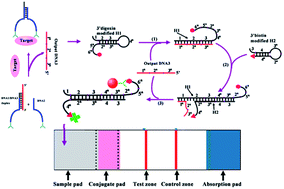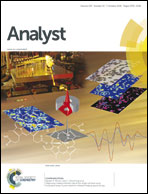Strip biosensor for amplified detection of nerve growth factor-beta based on a molecular translator and catalytic DNA circuit
Abstract
We have demonstrated a new visual detection approach based on a molecular translator and a catalytic DNA circuit for the detection of nerve growth factor-beta (NGF-β). In this assay, a molecular translator based on the binding-induced DNA strand-displacement reaction was employed to convert the input protein to an output DNA signal. The molecular translator is composed of a target recognition element and a signal output element. Target recognition is achieved by the binding of the anti-NGF-β antibody to the target protein. Polyclonal anti-NGF-β antibody is conjugated to DNA1 and DNA2. The antibody conjugated DNA1 is initially hybridized to DNA3 to form a stable DNA1/DNA3 duplex. In the presence of NGF-β, the binding of the same target protein brings DNA1 and DNA2 into close proximity, resulting in an increase in their local effective concentration. This process triggers the strand-displacement reaction between DNA2 and DNA3 and releases the output DNA3. The released DNA3 is further amplified by a catalytic DNA circuit. The product of the catalytic DNA circuit is detected by a strip biosensor. This proposed assay has high sensitivity and selectivity with a dynamic response ranging from 10 fM to 10 pM, and its detection limit is 10 fM of NGF-β. This work provides a sensitive, enzyme-free, and universal strategy for the detection of other proteins.


 Please wait while we load your content...
Please wait while we load your content...